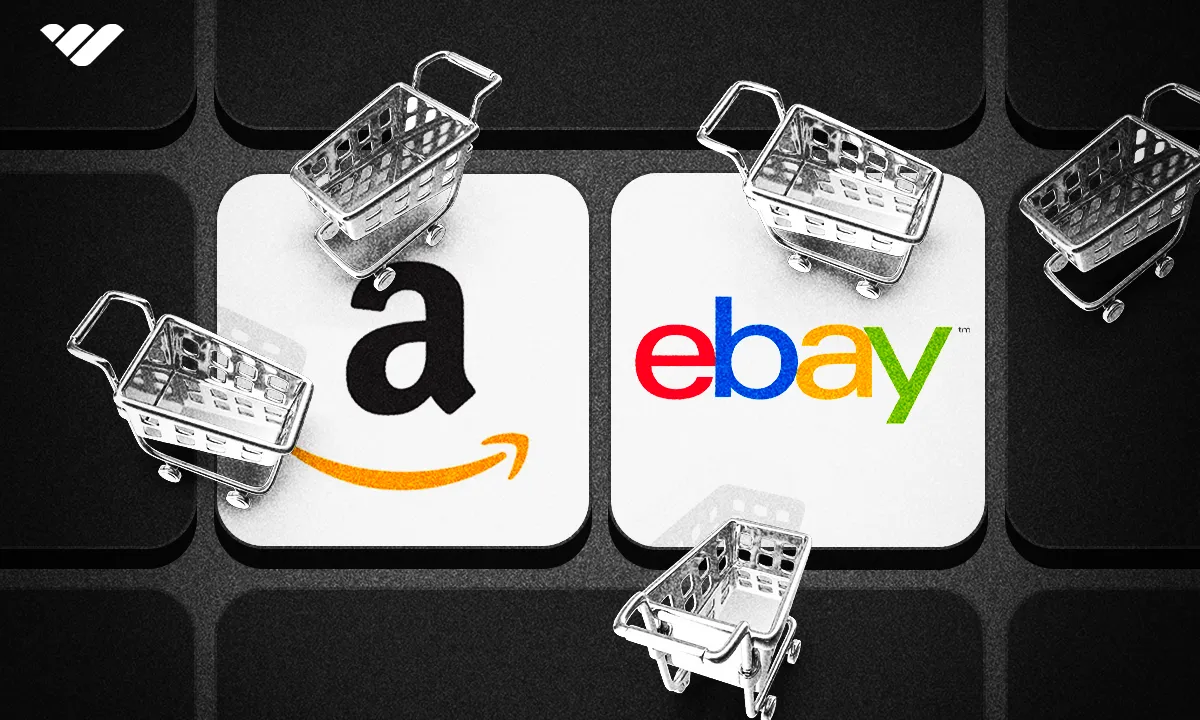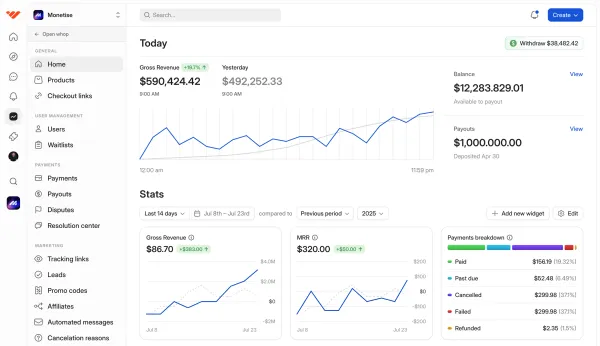Is Amazon or eBay the best place for an online seller? Find out in this guide.
Key takeaways
- Amazon has over 310 million active users worldwide with 80% from the US.
- Amazon FBA handles storage, packaging, shipping, and customer service for sellers automatically.
- eBay attracts 133 million active buyers across 190+ markets seeking rare items.
- Amazon charges $0.99 per item on individual plans versus $39.99 monthly for professional plans.
- eBay's auction format allows competitive bidding that maximizes profits on collectible items.
When it comes to buying and selling online, Amazon and eBay are usually the first names that come to mind. Both marketplaces have established themselves as online retail giants, offering thousands of product options for consumers and a thriving business space for online entrepreneurs.
Starting a business on both marketplaces may seem like a good idea, but exactly which one is the best option for your brand?
Keep reading to discover the advantages, disadvantages, and everything else you need to know to decide whether selling on Amazon or eBay is right for you.
Why should you sell on Amazon?
Founded in 1994, Amazon is an ecommerce company that began as an online marketplace for books and soon expanded to sell electronics, software, clothing, toys, jewelry, and many other types of products. It currently has over 310 million active users worldwide, according to Contimod, with 80% of those users coming from the US and is one of the largest technology companies in the world alongside Google, Apple, Microsoft, and Meta.
For business owners, entrepreneurs, and even individual sellers, Amazon’s massive scope provides a unique ecosystem that benefits businesses who don’t want to build a standalone ecommerce website.
With Amazon’s high trust and reputation among consumers, your product listings can reach an audience that already trusts in the platform you’re selling from.
When selling on Amazon you can leverage a level of organic traffic that very few online platforms can match.
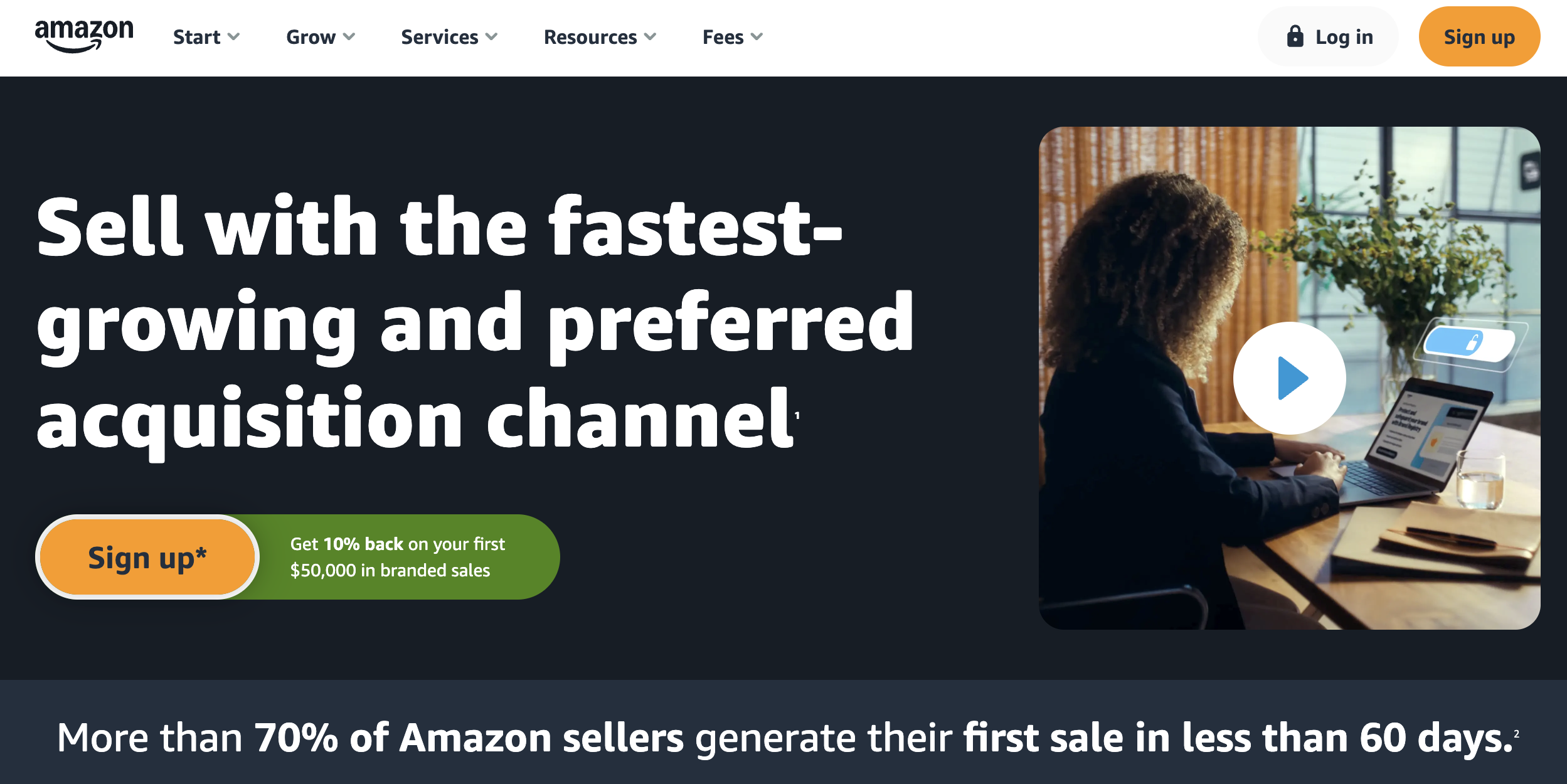
Selling on Amazon is relatively straightforward. While carefully planning and managing your listings properly is essential, the marketplace offers a user-friendly ecosystem that doesn't require extensive technical skills to set a storefront and start selling.
From experienced business owners, to first-time individual sellers, anyone can make a profit on Amazon with a proper list of the right products.
And along with its large reach and simple use, Amazon also offers sellers on the platform several features that make doing business much easier.
Programs like Amazon FBA (Fulfillment By Amazon), for example, takes care of much of the logistical procedures of ecommerce by storing your products directly into Amazon’s warehouses while also providing packaging, shipping, and even customer service for you. For you as a seller, it means more time to focus on other areas of your brand.
Recommended next reads:
- Is Amazon FBA still worth it?
- This 21-year-old entrepreneur makes 6 figures with Amazon FBA, and it all started with TikTok
Taking time to understand how to properly operate as a seller in Amazon, making use of its features and other benefits, can be very rewarding.
The size of the platform also means a more competitive environment, but with the right strategy and dedication, Amazon can be a powerful channel for building a sustainable and successful ecommerce business.
Why should you sell on eBay?
One of the pioneers in ecommerce, eBay was founded in 1995 and has since become one of the largest marketplaces in the world. It’s also partially responsible for popularizing the dropshipping business model, being an easy platform for both new and experienced sellers.
Its longevity and influence in ecommerce has made eBay a go-to platform for buying and selling, with 133 million of active buyers worldwide across more than 190 markets, according to eBay. This global reach allows you to tap into an international audience of buyers specifically looking for rare, unique items.
Starting on eBay is relatively simple and low cost, the platform provides sellers many tools and resources to help manage and grow their business. With eBay’s Seller Hub, you can monitor information about customer behavior, market trends inside the marketplace, and other performance metrics of your online store, helping you optimize your listings for better commercial results.
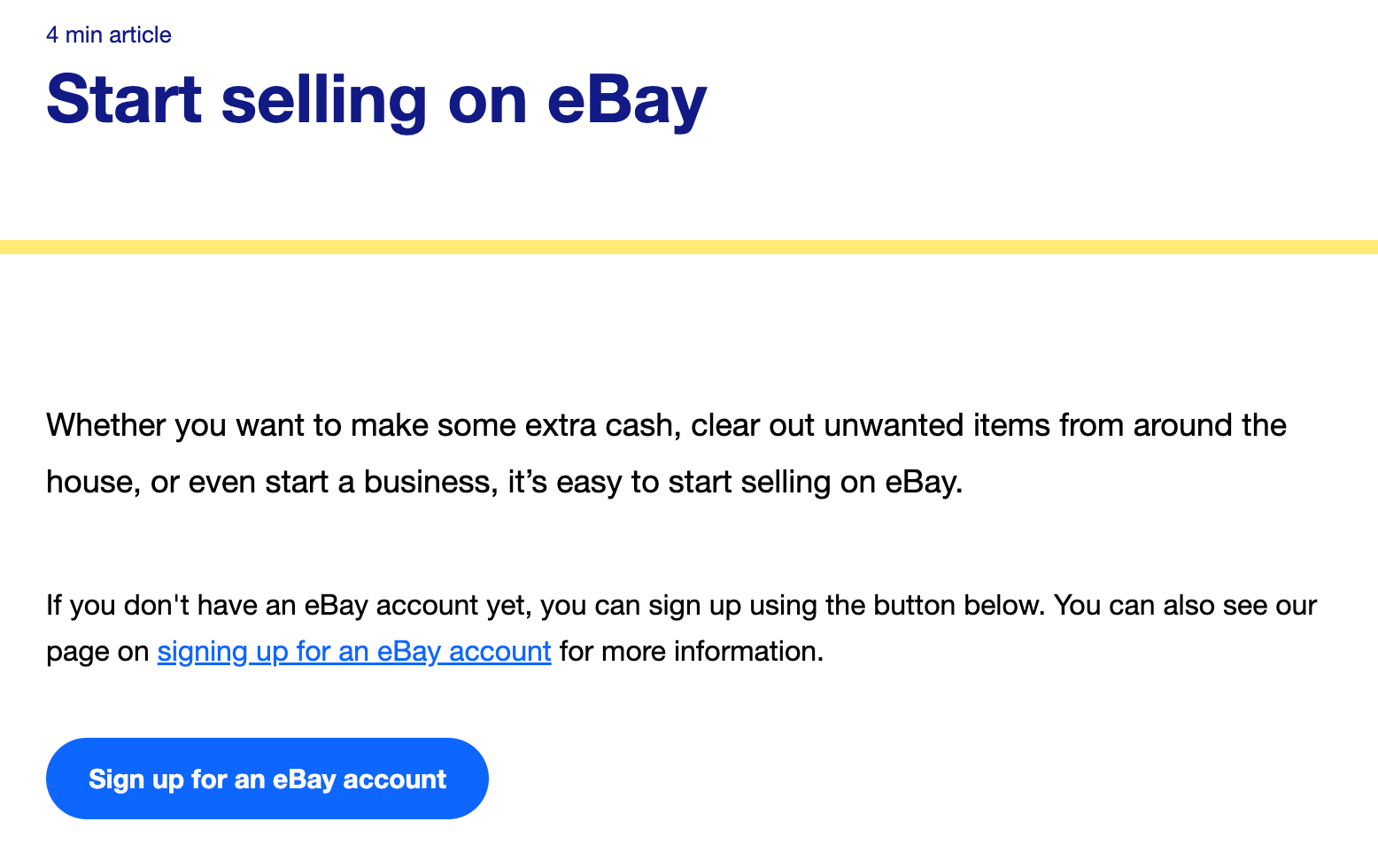
eBay also allows for a degree of negotiation that isn’t common in many ecommerce marketplaces. Setting your listings with the “best offer” feature allows buyers to make different offers for your products (that you can accept, counter, or decline) fostering a more interactive selling experience and increasing the conversions rates of your business, if negotiations are done well of course.
A flexible marketplace for sellers of all sizes, eBay is known for being a platform where collectors go to find rare and unique items. Whether it's old video games or exclusive cards, this niche of unique products can be beneficial for companies that focus on this segment.
- How to start Dropshipping on eBay: A beginner’s guide
- Best eBay dropshipping products of 2025, backed by research
What are the pros and cons of selling with Amazon?

With around 9.7 million sellers worldwide, according to Contimod, Amazon has several advantages that make it the central platform for many sales companies. But to know if it’s really the right one for your business, it’s important to understand that there are also disadvantages to consider.
Let’s take a look at the pros and cons of Amazon:
Pros of Amazon
Here are the main advantages of selling on Amazon:
Global presence
Being the largest marketplace in the world, is no secret that Amazon’s global presence is massive as well. The platform has distribution centers around the world, making it easier for cross-border selling, meaning you can sell your products to virtually anyone on the planet.
With Amazon’s established presence in the global market and offering the right products, your brand has the potential to quickly scale from domestic to international markets without the challenges of managing a global ecommerce operation from scratch.
Offers a simple selling experience
Like we said before, Amazon’s seller process is quite simple. The platform is intuitive and offers many resources that help new sellers with every step of their ecommerce experience. For instance, Amazon’s onboarding tools, tutorials, and customer support help streamline listing setups and account management.
Other features, like Amazon’s Prime program and Fulfillment by Amazon (FBA) service offer unique perks to increase product visibility as well. This feature can help sellers to focus on marketing and other strategies for traffic attraction rather than technicalities or fulfillment logistics.
It has strong data and marketing resources
Amazon offers robust advertising tools, including sponsored products and brands, paid reviews, and other marketing features in the platform. Additionally, the Amazon Connect—a service within Amazon specialized in analytics, insights, and optimization—provides sellers with deep info into consumer behavior, product demand, and category trends.
These data-driven resources, combined with Amazon's built-in customer review system, give you everything you need to optimize your business and create a well-rounded marketing strategy directly on the platform.
Diverse business options for sellers
Whether it’s electronics, furniture, clothing, car parts, school supplies, or even food, you can sell just about anything on Amazon. It’s this flexibility, combined with the platform’s vast reach and the potential for scalability for your business, that makes Amazon one of the top choices for ecommerce entrepreneurs.
But of course, some product categories simply sell better than others on the platform, and knowing that can be the difference between failure and success for your business. And just for the sake of curiosity, the best selling categories on Amazon are:
- Electronics
- Clothing, shoes, and jewelry
- Home and kitchen
- Beauty and personal Care
- Books
- Pet supplies
- Sports and outdoors
Cons of Amazon
Here are the main disadvantages of selling on Amazon:
The competition is fierce
While Amazon’s vast customer base is an advantage, it also brings intense competition. Amazon’s marketplace includes millions of sellers often competing within the same product categories. This competitive environment frequently results in price undercutting, making it difficult for new or smaller sellers to sustain healthy profit margins.
Additionally, as already mentioned, Amazon itself sells products across many categories. And if you sell electronics or gadgets, such as headphones or smartwatches, there’s always the possibility of competing directly with Amazon’s private-label products, benefiting from strong in-house promotions and higher visibility.
You have limited brand control
Amazon has specific policies that dictate how sellers can engage with customers. For example, the platform doesn't allow you to directly reach out your customers for marketing purposes or create personalized customer relationships, restricting the ability your brand may have to build customer loyalty.
You also don’t have much control over your brand on Amazon. You’re not allowed to direct customers within Amazon to external links, which can limit the possibility of cross-selling. Another factor to consider is that Amazon’s terms of use are constantly changing, which can even impact the product categories you can or cannot offer. For this reason, sellers on Amazon are always encouraged to pay attention to the platform’s policies.
The platform has strict guidelines
Amazon has strict guidelines that need to be followed, and failure to adhere to these can result in account suspensions or product listing removals, sometimes even without immediate notice or explanation from Amazon’s part. Issues like high return rates, inadvertent policy violations, or even a high flux of negative customer feedback can lead to suspension of your seller's account.
In such cases, you can send an appeal for the reinstatement of your account, but this procedure can be a lengthy and challenging process, especially if your business is reliant on Amazon as a primary sales channel.
Fees and costs can be high
While Amazon offers huge profit potential, the cost of selling on the platform can be high for new sellers. The platform charges selling fees and added costs if you decide to use many of the tools and programs it offers, such as Amazon FBA or Amazon Ads.
If you want more control over what you’re paying in terms of fees, Amazon offers two selling plans, individual and professional. On the individual plan you pay $0.99 per item sold with less features and tools. While the professional costs $39.99 per item sold, and you'll have access to all features Amazon has to offer.
It’s important to consider what tools, programs or plans you’re getting for your Amazon business, as fees on the platform can quickly eat into profit margins, especially for lower-priced items.
Pros and cons of eBay
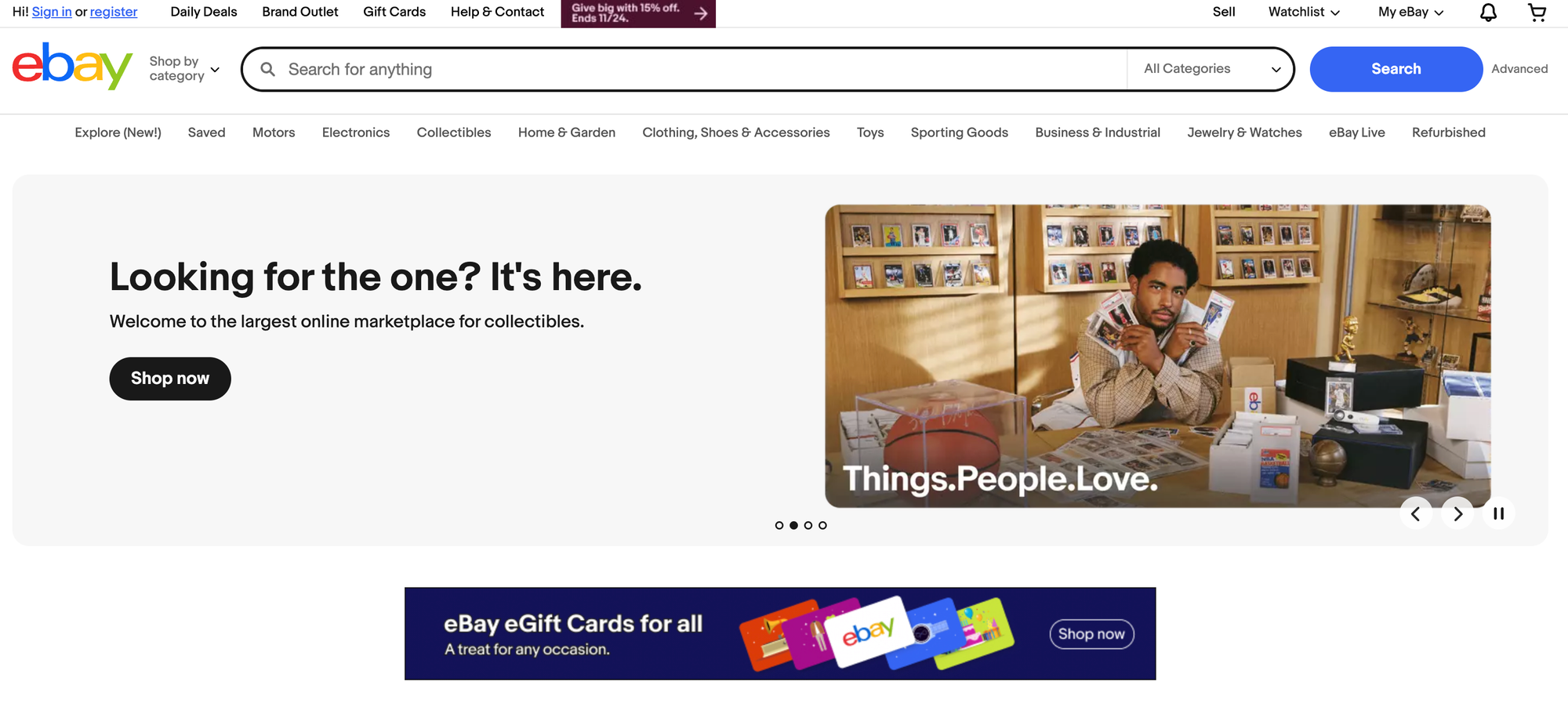
A staple in the ecommerce world for decades, sellers on eBay benefit from its large, diverse user base and flexibility in listing options, but the platform also has its own set of challenges.
Now let’s take a look at some of the main advantages and disadvantages of eBay as a selling platform for your brand.
Pros of eBay
Here are the main advantages of selling on eBay:
A marketplace with worldwide reach and strong focus on niche markets
eBay’s international scope opens doors for sellers to reach customers worldwide. This global reach is particularly valuable if you offer specialized products, as it provides a wider pool of potential buyers than a local or regional marketplace would.
One particular aspect of eBay is the fact that the marketplace attracts buyers specifically looking for rare or one-of-a-kind items like collectibles, trading cards, and vintage items. This niche aspect combined with international reach makes the platform an ideal space to sell specific products anywhere in the world.
It offers diverse selling formats
The marketplace offers a variety of listing formats that can provide you with unique opportunities to maximize your profits. eBay’s classic auction format can be highly beneficial for rare, collectible, or high-demand items, as competitive bidding can drive up the final sale price.
Additionally, the “Best Offer” feature gives you flexibility to negotiate prices. This control over pricing and methods of selling makes eBay a great platform to experiment with pricing and capture buyers looking for the best prices and willing to bargain.
It has a friendly fee structure
eBay’s fee structure is transparent, with the marketplace primarily charging final value fees on completed sales that varies depending on the category of the product sold.
For example, when selling products in the “jewelry & watches” category (except parts and accessories, according to eBay’s customer service guides) the final value fee is gonna be 15% if total amount of the sale is $5,000 or less, calculated per item; or 9% if total amount of the sale is over $5,000, calculated per item.
Starting on eBay is relatively simple and low-cost, new sellers can often list items with little or no upfront fees, making it easier for small businesses or individuals to test the platform without a significant financial commitment.
Strong support for both new and used products
Known for its acceptance of both new and pre-owned items, eBay has built a reputation as a go-to site for bargain hunters, collectors, and those seeking discounted items. For you as a seller, this opens up a range of potential product offerings without the limitations—and with way less strict requirements—that some platforms impose.
Amazon or eBay: Which is best for your business?
As two ecommerce giants, choosing between Amazon and eBay can seem confusing to some. However, choosing the right platform for your business can directly impact its performance within each marketplace.
To choose which is best for your business, it’s important to consider factors such as:
The kind of product are you offering
The nature of your products can significantly impact which platform suits your business better.
Amazon, for example, excels at selling new, modern, and widely recognized products, like electronics, gadgets, home goods, and personal care.
Meanwhile, eBay is popularly known for unique, vintage, and exclusive items, like rare card games, old consoles, collectibles, and one-of-a-kind items. Products that don’t fit into conventional mass-market categories.
You can definitely sell anything on both platforms, but centralizing your business in a space where it can be most prosperous is a more efficient sales strategy. You can also simply search in each platform’s best selling lists and compare. If the type of product you’re offering is high on the list, it might be a good idea to sell there.
Who your target audience is
A crucial step in determining the best platform for your business is understanding your audience shopping habits.
Shoppers who visit Amazon often have high purchase intent, searching for new products and best-sellers. eBay, on the other hand, has long been synonymous with auctions and bargain hunting, appealing to shoppers who enjoy the thrill of finding unique items or negotiating prices.
Read this article to understand how to create a target persona.
If the platform alights with your goals and resources
As we’ve shown throughout this article, both Amazon and eBay have guidelines and specifications that must be followed in order to operate on their marketplaces. And these same elements are important to take into consideration, as a usage policy that goes against what you offer, or a fee that is higher than your resources can cover, might end up harming your business as a whole.
Learn how to sell anything, anywhere with Whop

With Whop, you have access to incredible communities led by the best ecommerce experts on the market, ready to teach you everything you need to know about how to run a successful business whether on Amazon, eBay, Etsy, or any other marketplace out there.
You can learn about how to create and sell digital products—such as online courses and guides—how to effectively start a dropshipping company, and even how to be a big player in the lucrative world of sports betting, all through communities full of entrepreneurs who, like you, are eager to make money on the internet.
Are you going to miss out on the opportunity to make all your ecommerce dreams come true? Learn from the best with Whop.
Selling on Amazon vs eBay FAQs
The frequently asked questions about selling on Amazon vs eBay
Is it more cost-effective to sell on eBay or Amazon?
It depends on your business model. Amazon's fees can be higher and more complex, especially if you use FBA, while eBay generally has more straightforward fees, which might be more cost-effective if you handle your own shipping and operations.
What types of products sell better on eBay and Amazon?
While you don’t have restrictions in terms of what type of products you can sell in eBay and Amazon— as long as they comply with the terms and policies of each platform—eBay is often used for enthusiasts and collectors looking for specialty products or deals. While Amazon, in contrast, is more suitable for mass-market, new products, offering convenience and fast shipping.


